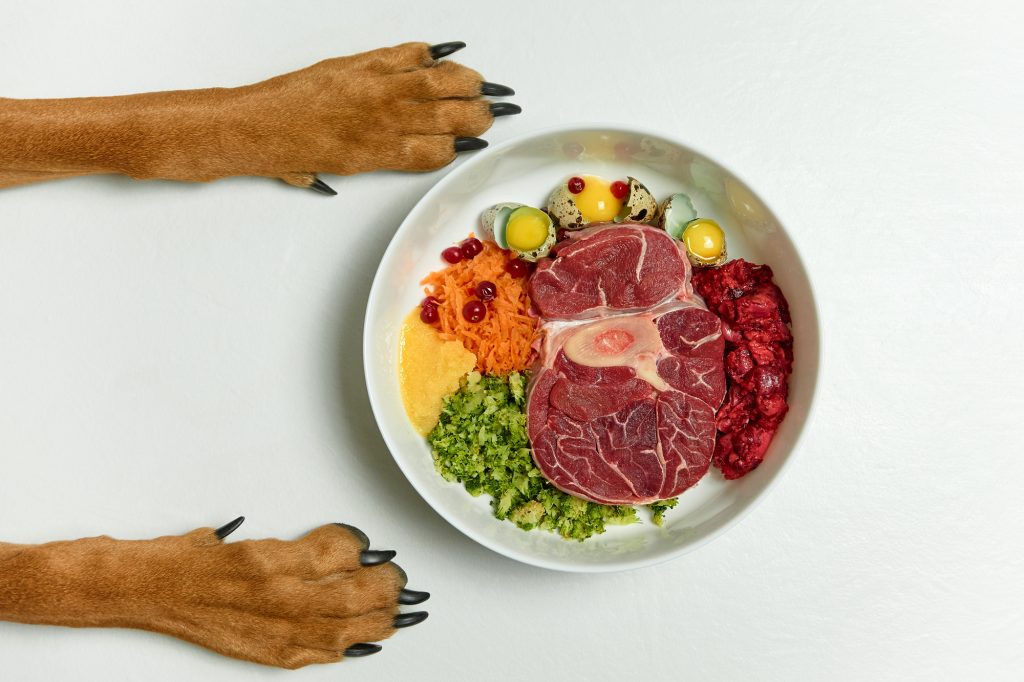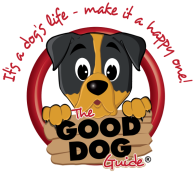Dogs are like members of the family, so you want to serve them meals that make them both healthy and happy. These days, you have lots of different choices about what to feed your dog, so picking the best dog food for your pet can be confusing. In this helpful guide, you’ll find out about the four main types: Dry, wet, raw and semi-moist dog food. You’ll see that they differ in their content, convenience, cost and more. After you review the pros and cons of each, you’ll have everything you need to choose the best dog food for your furry friend.

Dry Dog Food
Benefits of Dry Dog Food
Dry dog food, often referred to as kibble, is a blend of meat, grains and vegetables that’s cooked, dehydrated and formed into pellet-sized pieces. The contents can vary from brand to brand, with low-quality products leaning heavily on wheat, soy and corn to provide bulk and extra calories.
The best dry dog food can provide most, if not all, of the nutrients your pup needs. If your pet is a grazer and doesn’t eat a whole serving at once, kibble can sit out all day without spoiling. It’s also less messy for you to clean up after the inevitable dinnertime spills. Dry dog food is the most cost-effective type because it tends to be cheaper per serving and it’s easier to buy and store in bulk, which lowers your daily price. The rough edges of dry dog food can help remove plaque and tartar from your dog’s teeth, which seems much easier than trying to brush them yourself.
Not every dog will be satisfied with a dry food diet, though. Kibble does not have the taste and smell appeal that the other types have for dogs. Dogs that are accustomed to wet food or table scraps may turn up their noses at plain dry dog food.
If you do opt to feed your dog dry food, check the ingredients list before you buy. The first one should be the protein source, such as beef, chicken or lamb. If grains are included, choose products with whole grains such as barley and not nutritionally poor wheat or corn meal. The best dry dog food is free of artificial sweeteners, colors and preservatives.
Varieties and Special Needs
Dry dog food brands offer products that are specifically formulated to meet the nutritional needs of older dogs, puppies, and overweight dogs. If you have a larger or very small breed, look for dry dog food that’s designed for them. Dry dog food products also are available for pets that have allergies to grains or other ingredients.
Real-Life Examples and Recommendations
A good way to learn about the best dry dog food is to check out online reviews by customers who have tried the products. For instance, one pet owner reports that “My two-year-old dog named Rosie is in love with kibble made from salmon. Usually, she is a pickier eater when it comes to kibble, but she finishes it so fast.” Other families say that switching to a specially formulated dry dog food reduced their pets’ allergic symptoms almost immediately.
Wet Dog Food
Advantages of Wet Dog Food
Wet dog food has a high moisture content and it typically comes in cans or small pouches. These products generally have a more appetizing flavor and aroma for most dogs. Wet dog food also is easier to chew, which may be important for older pets and those with health issues. The water content of wet dog food helps to ensure dogs stay well-hydrated and it can keep them feeling full for longer after eating than dry dog food does.
Wet dog food is messier and has a stronger smell, which you may not like as much as your dog does. Wet dog food is quicker to spoil than dry dog food, so you may have to throw out whatever your dog doesn’t eat right away. Also, the cans and pouches can make it harder to serve your dog smaller portions because the leftovers are so perishable.
Today, you can subscribe to one of the delivery services that offer healthy wet dog food based on your pup’s particular needs. The best wet dog food is made with human-grade ingredients and includes nutritious vegetables such as sweet potatoes. These services typically package the meals to the portion size that’s right for your dog. These meals come either frozen or refrigerated, so you need to plan for storage.
Special Formulas
Just as with dry dog food, wet dog food delivery companies and brands offer products made to nourish dogs at different stages of their lives, from newborn to seniors. Healthy wet dog food products can help your pet lose weight and provide relief from food allergies or other health problems. Beef, chicken and pork are standard protein sources in wet dog food, but you can also find those made with duck, buffalo and other natural ingredients.
Case Studies and Owner Experiences
Pet families often find that their dogs’ tastes and needs change. One wet dog food customer notes that “I have a dog that’s now a mom to two pups and she normally has had dry dog food since I’ve had her. Currently she is now only wanting wet dog food.” A family with four dogs shares that they and their pups prefer wet dog food because “it’s easy to mix into dry food. And old man Teddy, who doesn’t have bottom teeth, likes how soft it is.”

Raw Dog Food
Understanding the Raw Food Diet
Many pet owners today choose to feed their dogs raw food based on the belief that it is healthiest because it is like the diet their wild ancestors ate. Raw dog food usually includes high-protein organ meats such as liver and kidneys, ground bones, uncooked eggs, and carefully chosen fruits and vegetables. You can buy raw ingredients yourself, but raw dog food products also are available packaged and shipped refrigerated or frozen, or it may come freeze-dried. Advocates for a raw food diet claim that it helps maintain a healthy weight, improves digestion, increases energy and promotes a shiny coat.
Some veterinarians warn that raw diets are not appropriate for dogs who share their homes with young children or people with compromised immune systems, according to the American Kennel Club, because of the increased exposure to harmful pathogens in raw ingredients. Dogs with pancreatitis, cancer or other health conditions may need their food to be cooked so they can digest it. Puppies are also better off having cooked food, says the AKC. Before starting your dog on raw food, discuss the plan with your veterinarian.
Preparing and Calculating Raw Food
If you’re thinking of preparing raw dog food yourself, be aware that you need to be especially careful in buying, handling, serving and disposing of the ingredients. Raw ingredients can carry foodborne illnesses that are normally killed by the heat of cooking.
Preparing raw dog food yourself also requires attention to the particular nutritional needs of your dog. Look for recipes that fit with your dog’s age, weight, breed, activity level and overall health. You can also find raw dog food “calculators” online that help you figure out what and how much to feed your dog.
If you’re not certain you can handle both the food safety requirements and nutritional balancing needed to give your pet homemade raw dog food, check out one of the delivery services that package and portion raw meals just for your pup.
User Stories and Reviews
Pet families who start feeding their pets raw food tell of dramatic improvements in the animals’ digestion, energy levels and appearance. One dog owner has shared that “We have five little dogs and one is particularly finicky with food.” When fed with a packaged raw dog food, “each of their bowls was completely cleaned out within thirty seconds. And the picky guy might have been the first one done.” The family of a chihuahua poodle mix says that he “had so many infections and vet bills up to the roof until I decided to put him on a raw diet and have never looked back to kibble again.”
Semi-Moist Dog Food
The Balance of Semi-Moist Food
For some families, semi-moist dog food offers the best of dry and wet foods. Semi-moist food has a higher moisture content than kibble, so it’s easier to chew and digest. Semi-moist food is less messy and easier to handle than wet food. It is as shelf stable as dry dog food. Be aware that many semi-moist dog food brands add more salt and sweeteners to their products than is usually found in wet dog food or kibble. Semi-moist dog food may also contain substantial amounts of artificial flavors, colors and preservatives.
Brand Analysis and Options
As with wet food, the best semi-moist dog food is prepared with human-grade ingredients. Check the ingredient list for real meat (no meat meals or by-products). That should be the first ingredient on the list. Veterinary nutritionists suggest that you look for semi-moist dog food with coconut oil, which has antibacterial properties that protect dogs from diseases that afflict their teeth and gums. Because of the ease of chewing semi-moist dog food, it’s especially popular for families with older dogs.
When shopping for healthy semi-moist dog food, look for products that have been air-dried. This process preserves more nutrients in the food than high-temperature dehydration does.
Consumer Insights
Semi-moist dog food has been a big hit with the family of a 70-pound American Staffordshire/bulldog mix. “He has a sensitive digestive system and it is very hard to find food for him that is healthy and free of synthetic and non-digestible items,” they report. “Properly formulated air-dried food is the next best choice and he loves it.” The family of a “very finicky Malshi (Maltese / Shi Tzu mix)” loves the semi-moist food because “it’s much more convenient than moist food.”
Conclusion
You have many choices for feeding your dog. Dry, wet, raw and semi-moist dog food can all provide dogs with the nutrients they need to stay healthy and active. They differ in their appeal to dogs and in their convenience for you. Dry dog food typically is the least expensive and the easiest to store, followed by semi-moist food. Wet and raw food tend to excite dogs more, but they can be messy and smelly, and they are more perishable.
So what’s the best dog food for you? That depends on your dog’s individual needs, preferences, and health conditions. As you’re evaluating the options, consider the food’s ingredients and nutritional content, their taste and smell appeal to your dog, and your dog’s age, breed, size, and activity level. Cost also is an important difference between dry, wet, raw and semi-moist dog food. You can find all types of dog food in specialty stores and online. Ultimately, the best dog food is the one that your pet loves to eat and provides the nutrition they need to stay healthy—just what you want for any member of the family!
Article Supplied
